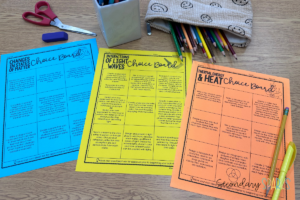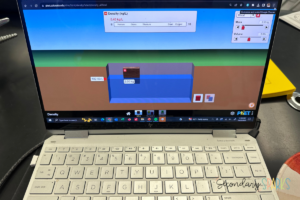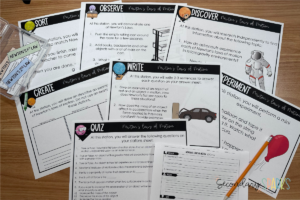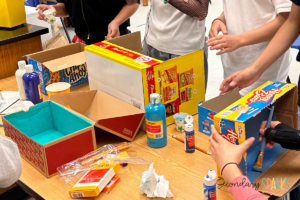There are lots of things that vary from classroom to classroom across the country, but one thing is guaranteed: our classrooms are filled with individuals. Each individual student learns differently, has different preferences, and demonstrates knowledge differently. So, it’s critical as teachers that we work to meet the diverse student needs in our classrooms. Below are some of my favorite ways to support diverse learners in the classroom.
#1 Digital notes
For some students, handwriting notes is a huge barrier, and typing is much easier. Not to mention, typing can be easier to organize – which is great for visual students.
I like to help students organize by using guided notes. You can check out my Earth and Space Guided Notes and Physical Science Guided Notes.
#2 Choice Boards
Creating opportunities for student choice is a great way to meet the needs of diverse students in your classroom. Choice boards make it possible for students to present their knowledge in a creative way. I’ve had students create posters, podcasts, Canva presentations, 3D models, and more!

Want to try choice boards in your classroom? Check out the no-prep Physical Science Choice Board.
#3 Activities that Get Students Moving
Support your kinesthetic learners by turning task cards into a gallery walk or setting the classroom up into stations so students have to move from table to table.
#4 Assessment Strategies
Mixing up assessment types is a great way to adapt to the diverse learners in the classroom. Some students may excel at written tests, while others may prefer a project, presentation, or even a verbal assessment. A bonus to mixing up the assessment strategies is that some alternative assessments are way easier to grade.
#5 Hands-On Activities
Any time I can incorporate a hands-on activity, I do. Labs are probably the most on-the-nose way for a science teacher to get hands-on. Personally, food labs are my favorite because they are fun, and you have a delicious snack at the end. Win-win!
#6 PhET Simulations
Labs don’t always have to be in person. You can support diverse learners in your classroom with digital simulations, too. These PhET simulations are free and great for labs that are costly (or generally unrealistic in the classroom).

#7 Stations
Just like choice boards and alternative assessments, giving students different ways to show and practice their skills is always beneficial. Stations are a tried-and-true way to support diverse students in the classroom. You can alternate between written, hands-on, and digital activities to meet every student’s needs.

Check out some of my low-prep science stations to get started.
#8 Review Games
Some students absolutely thrive when you toss in the element of competition. Review games add some extra fun and engagement, too! Try using Kahoot!, Jeopardy, relay races, and more to infuse competition into your classroom.
#9 Project-Based Learning
PBLs are unique in that there is something for every learner within the project. PBLs present real-world problems or scenarios for students to analyze and solve using their scientific knowledge. They usually include cross-curricular concepts and even include some creativity.

#10 Virtual Field Trips
While real field trips are amazing and provide fantastic learning opportunities for diverse learners in your classroom, not every school allows field trips (or has the budget). Virtual field trips are a great option in lieu of physical field trips, and you’d be amazed by how many you can find online!
No matter where you teach, it’s all but guaranteed that you’ll have diverse learners in your classroom who all learn and apply knowledge in different ways. I hope these suggestions help you adapt your science lessons and make it easier to support every learner in your classroom.

[…] provide a hands-on and interactive approach to learning with opportunities for mini-experiments, science demonstrations, observations, and […]